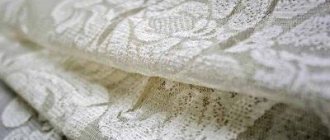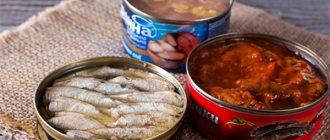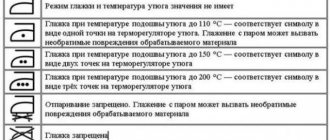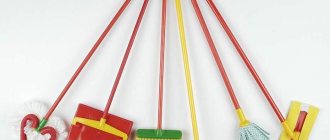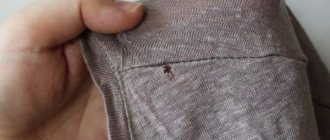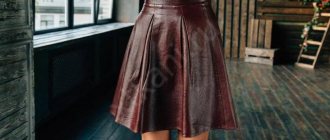Natural and synthetic fabrics have long been present in our everyday life. Polyester fabric, or polyester fabric, is also called raincoat fabric. It is durable, durable and easy to maintain. Outerwear is made from it. During washing, this fabric does not shrink or wrinkle. But sometimes things require ironing.
Polyester outerwear should be ironed with care
How to Steam a Raincoat at Home?
A polyester jacket or raincoat can be ironed in the following ways:
- Using a steamer (steam generator) or an iron with a vertical steam supply function (steam boost). ...
- You can steam the raincoat using wet natural fabric (cotton).
21 Jul.
2016 Interesting materials:
Can tiles be laid on laminate flooring? Can tiles be laid on tiles? Is it possible to lay floor tiles over old tiles? Is it possible to glue washable wallpaper in the bathroom? Is it possible to glue wallpaper a week after priming? Is it possible to glue wallpaper over old paint? Is it possible to feed rabbits Snitya grass? Is it possible to feed quails millet? Is it possible to feed pigs fodder beets? Is it possible to feed pigs flour?
How do material characteristics affect the process?
The material from which the raincoat is made plays an important role when choosing the ironing method.
It is necessary to take into account:
- the material itself;
- presence of lining;
- style features;
- the presence of decorative elements and finishes.
Leather
A leather raincoat is an easy-to-wear item that is very practical. The difficulty of smoothing such a product depends on the quality of the leather.
Soft, pliable natural leather responds well to smoothing. Such a raincoat can even straighten out under the influence of its own weight if it hangs freely for several days.
But this method is not suitable for thick, rough skin with compacted creases . Iron a leather raincoat in compliance with the following conditions:
- only through additional fabric;
- at minimum temperature;
- without steam function on the iron.
In addition to the option with an iron, exposure to steam helps to straighten a natural leather item . This can be done using a steamer.
Another option is to hold the item on a trempel over a bathtub filled with boiling water.
The rising steam will soften the skin, which will lead to straightening of creases . A suede raincoat cannot be ironed, but it can be steamed over a bathtub.
Linen and cotton
Natural fabrics are used to sew lightweight items intended to be worn in late spring or cool summer.
Such a thing can be ironed well at the temperature set according to the information on the label or at the “cotton” mode. But it is necessary to take into account the presence of a lining.
A light linen or cotton raincoat may not have a lining. If there is no lining fabric, you must adhere to the following order:
- The product is ironed from the inside out at a temperature permissible for cotton - up to 200ºС.
- Steam function enabled.
- It is advisable for the product to be slightly damp. If it has been washed, then iron it without waiting for it to dry completely. For very dry fabric, it is necessary to pre-wet the material with water using a spray bottle.
- Ironing from the inside is preferable to ironing from the front.
If there is a lining:
You can iron the raincoat from the wrong side or from the front (preferably through additional fabric).- When ironing from the inside out, the heating temperature must be set taking into account the maximum possible for the lining fabric.
- It is better to iron on the front side through a thick, damp cloth. This will help preserve the brightness of the shades and the appearance of the fabric for longer.
Linen and cotton allow the use of fairly high heating temperatures . But if the composition of the material is dominated by synthetics, the temperature on the iron should be set to a lower value.
Polyester
This material is often used to make a raincoat. Not only does it wash well, but when dried properly on a tray, it practically does not wrinkle.
If a polyester item is folded and stored compressed between seasons, it may become wrinkled.
It is necessary to iron with a warm iron, very carefully. It is better to start ironing polyester with a low temperature, gradually increasing it.
Choice of colors and styles
For plus size women, thick fabrics such as denim are suitable. It forms a silhouette, hides folds and bumps. In summer, denim shorts can be hot, then choose thick cotton and linen, or thin suede. The fabric is light, the skin breathes.
Black, blue, dark green are not a stereotype; such shades really make you look slim. If you want brightness, then it is better to give preference to monochromatic models, with frequent small patterns or vertical stripes.
Shorts with fringe and lace at the bottom can be both short and cover the legs. The best styles are high-waisted. Fashionable and slimming option: high waist, belt (positioned so that the fabric above it gathers slightly), vertical stripes, length just above the knee, loose fit, pockets.
Don't be afraid of wide and very wide shorts and turn-ups. The length can be any (but not extreme mini) - if it is close to the knee, and the style is straight, then these are Bermuda shorts. They hide curvy hips, emphasize straight legs, look good with any clothes and serve as a base for different looks.
Using a steamer
To steam a product, make sure that the fluff is distributed evenly over it, not crumpled, and straighten the material itself with your hands.
Hang it on hangers in such a way that you can get to it from all sides without making contact with the item itself. Study the recommendations provided on the label. If the iron setting is indicated there, follow the instructions. When this information is not available, start steaming at the lowest temperature on a small area of clothing.
Monitor the reaction of the fabric to hot steam, this will help you find the optimal position of the regulator. Now that you are completely sure that the temperature is appropriate, continue processing the surface. Steam must be directed from a distance of at least fifteen centimeters.
Care instructions
- When washing coats by hand, it is not recommended to rub the fabric against each other. It is enough to carefully turn over and compress the product, after placing it in a special bag for washing. With this approach, the likelihood of unnecessary folds will be significantly reduced;
- At the end of the washing process, there is no need to twist or wring out the material. It is enough to hang it over a basin or bathtub to drain off excess moisture;
- When washing, it is recommended to use special fabric softeners. This will add freshness, softness and reduce the risk of unnecessary wrinkles;
- It is recommended to iron a wool coat when it is not completely dry (there are exceptions, so you should carefully read the instructions on the tag).
In order for the item to remain neat and new in appearance longer, you must strictly follow the listed rules.
If you have any doubts about the idea of washing and ironing your coat yourself, you can take it to the dry cleaner and entrust the job to professionals. Specialists will return the original appearance to any type of fabric. What to wear with a black jacket What to wear with a red coat
Is it possible to iron faux fur items?
Products made from faux fur are worthy competitors to fur coats and vests of real mink, fox, astrakhan fur, mouton, and chinchilla. They are inexpensive, beautiful, durable, and quite easy to care for. However, if the care rules are violated, they can be irretrievably damaged.
Such products should only be stored in a straightened state, on hangers, avoiding being crushed by other things. If you simply fold the fur coat and put it away until better times, then unsightly creases will appear on the surface. The question arises, how to iron faux fur? You should immediately forget about the iron: artificial bristles glued to a synthetic or natural base will simply melt under the influence of the iron, and at best they will lose their smoothness and shine.
So if you are going to iron a fur vest or fur coat, then remember that you will have to carry out the work without an iron. It is strictly prohibited to influence artificial fur using any temperature method. You should neither dry such products in the sun, nor dry them with a hairdryer, nor leave them near a hot radiator or heater.
How can you smooth out faux fur? Unfortunately, the only way to try to fix the situation is to wet the fibers along with the base and hope for the best.
- A fur coat or vest should be washed by hand or in a washing machine (if this method of care is acceptable).
- Do not wring out the pile strongly (it gets tangled easily, wrinkles, and may begin to fall out of the base, especially if the glue was of poor quality).
- When wet, hang the product on wide hangers.
- To smooth out fur on artificial fabric, run your hand over it, trying to straighten out any creases as much as possible.
- Allow the product to dry at room temperature, periodically ironing the fold with your hands.
Unfortunately, that's all that can be done.
How to clean stains from raincoat fabric
To clean stains, use ammonia, soap solutions, plain water, and sometimes gasoline. Do not use stain removers as they may damage the fabric. Rub stains from edge to center using a rotating motion, avoiding clean areas.
To wipe, use a cotton pad, swab or swab. After treatment, immediately moisten the cloth around the treated area with water.
To clean the collar of a jacket, raincoat or windbreaker, to remove dirt and greasy areas, use a vinegar solution. To do this, dissolve half a teaspoon of vinegar in a glass of water, moisten a swab and wipe the damaged areas.
You can remove stains from cosmetics or perfume using gasoline. After treatment, rinse the area with a cotton pad soaked in clean water.
Sour milk whey will help remove grease stains. Treat greasy stains with this product, and then wipe the material with a solution of ammonia and salt.
To do this, mix one tablespoon of salt and ammonia with a glass of water. Then wash the fabric with a soft cloth soaked in a soap solution of liquid soap or crushed solid soap.
You can remove street splashes and rain stains with a soft brush dipped in a soapy shampoo solution. Place the product on a hard surface and place a thick cloth under the contaminated area.
Then use a brush and soapy water to scrub the area. Rinse the fabric with a damp cloth and wipe dry. Finally, you can wipe the area with a weak solution of ammonia.
Using an iron
We have come close to the question of whether it is possible to iron a down jacket with an iron. This procedure is no different from ordinary ironing. It’s better to start by trying to stroke a small area through gauze to check the effectiveness and stability of the fabric.
But this manipulation may not be necessary if the label indicates a ban on using an iron or tells you at what temperature it is better to do this work.
If there are no restrictions, and you are ready to begin, you need to straighten the parka on the ironing board, face up.
- Take gauze or ironing cloth designed for delicate ironing, carefully straighten the item and place a protector on it.
- Having set the minimum temperature, begin the procedure.
- The inside is ironed without gauze.
This method is the most labor-intensive, since smoothing sleeves and hard-to-reach places is not so easy.
Recommendations
Ironing a raincoat at home can be quite easy if you take into account the following tips :
Before you start ironing, you need to examine the label from the inside. It indicates the composition of the fabric and the rules for caring for the product.- It is advisable to iron only clean items.
- All pockets must be checked and foreign objects removed.
- Additional removable elements, such as a belt, must be removed. They are processed separately.
- The material through which the raincoat is ironed should not fade. The ideal option is to use a piece of white cotton fabric.
A raincoat is a fairly long item that needs to be stored loosely on hangers under a cover .
How else to soften a leather jacket
If you often wear leather goods and want the material to look good, even if it is not entirely new, it is better to get special products that will help you with this. You don't have to buy them in a store - they can be found in natural substances and your everyday environment.
Castor oil to the rescue
An affordable and cheap product - you can buy it at any nearest pharmacy. Its oily and thick structure is absolutely harmless to the skin and helps to extremely effectively soften material that has not been worn or, on the contrary, has become roughened by time.
Take a thick rag so as not to get dirty, scoop up the oil and generously lubricate the skin around the entire perimeter. It is better to repeat this at least three times, but castor oil is poorly absorbed, so you will have to pause between procedures. Hang the jacket over the unnecessary fabric if you suddenly overdo it with oil.
Vaseline comes into play
There is no more universal remedy in our everyday life than Vaseline - it equally well promotes the healing of small wounds on human skin, softening products, and even a kind of rejuvenation of leather products. Ideal for elegant women's jackets, as it is colorless and does not leave odors.
Rub the skin thoroughly, squeezing the Vaseline directly from the tube until you feel it is moist enough.
Shoe polish is also useful
Those who use shoe creams to care for leather jackets are in fact completely right - there is nothing in these useful creams that would harm an expensive item of clothing.
You can apply the cream using a clean shoe brush, always without grains of sand. Consider the color of the cream (black or brown), if it is not colorless.
Egg white - an unusual but effective way
If you don't have anything on hand, you can use egg whites. Carefully separate the yolks, pour the whites into a deep bowl and beat thoroughly until foamy. It's better to use a mixer.
Generously soak a cloth in the resulting liquid and rub into the jacket. Most likely, it will drip - keep this in mind when choosing a place to hang your clothes. After four hours, wipe off what is not absorbed and leave the jacket to dry.
Citruses will add not only softness, but also a pleasant smell.
Buy a few lemons or oranges, cut them into slices and wipe the entire jacket well, sparing the juice.
After a couple of hours, the product needs to be wiped off from sticky marks, but the procedure can be repeated two or three times.
An additional result will be a subtle pleasant smell of the citrus used. It won't be long lasting or irritating, but will last for a few days.
How to iron a sheepskin coat safely - learning ways
There are many ways to iron a sheepskin coat without resorting to the services of professionals.
- Method one: let the product hang on hangers for one to two weeks. Yes, it takes a long time, but it is completely safe.
- Method two: steam the sheepskin coat over a bath of hot water. The bathroom should be tightly closed to keep the hot steam as long as possible. The “bath” time is about half an hour.
- Method three: treat the jammed areas with a steamer on an iron or a special steam generator. Processing each fold should last approximately twenty minutes. The permissible distance to the surface of the product is ten centimeters.
- Method four: ironing. You can iron the folds on a sheepskin coat with a regular iron. The temperature should be minimal, without steaming. Ironing must be done through thin wrapping paper.
Important! When steaming a sheepskin coat, you need to ensure that moisture does not get (or form) on the surface. This can ruin your skin.
Conclusion
We hope our article will help you quickly put in order such outerwear as a raincoat, sheepskin coat, or faux fur coat. We will be glad to see your comments on the article!
